Origins Of Marine Corps Base Camp Lejeune
Evolution of Amphibious Assault and Base Defense Missions
History of the Marine Corps
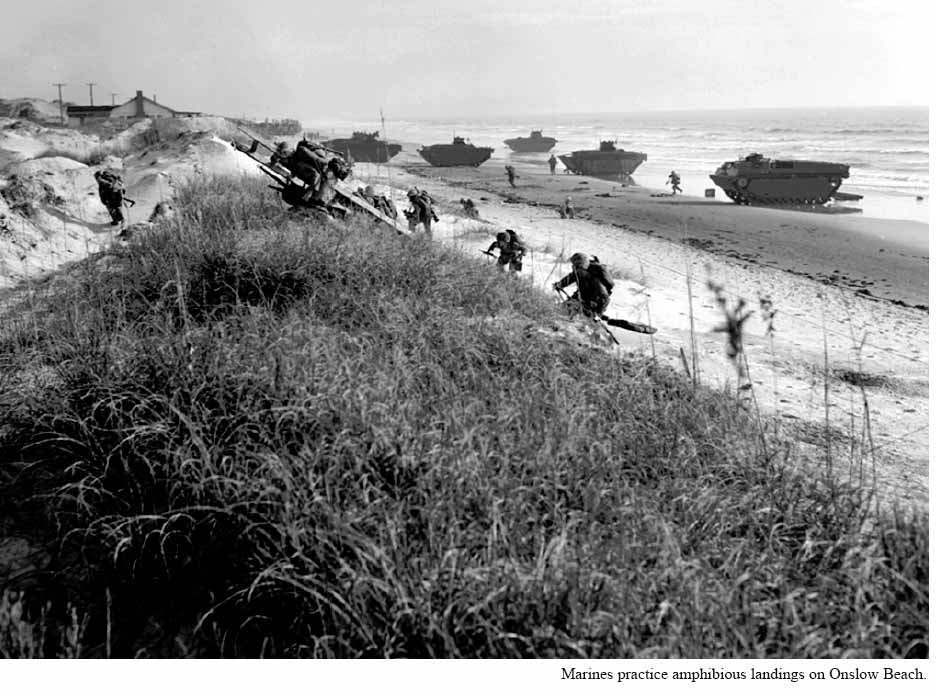
The Marine Corps is one of the several armed services that constitute the Armed Forces of the United States. Established by the Continental Congress in 1775, and re-established in 1798 after the American Revolution with a total of 83 officers and enlisted men, the Marine Corps had evolved by the twentieth century into a distinctive branch of the military with over 170,000 personnel that fulfill the need for a general-purpose, task-organized, amphibious force in readiness. Although under the direct control of the Secretary of the Navy, the Marine Corps remains a separate military service with its own specific roles and missions. The Corps is assigned "the missions of seizure and defense of advanced naval bases, as well as land operations incident to naval campaigns," provides security to the ships and shore stations of the U.S. Navy, and is primarily responsible for the "development of amphibious warfare doctrines, tactics, techniques, and equipment employed by landing forces."
Pre-World War II
Prior to World War II the missions of the Marine Corps had included the second task mentioned above[MG1] , the detachment of security units to the ships and shore stations of the U.S. Navy, plus expeditionary duty in support of the State Department and cooperating with the Army in protracted land campaigns. As part of the first task, Marines were to defend the Navy's far-flung advance bases in conjunction with the Navy's plans for defending U.S. territorial possessions and other "interests" in the Pacific and Atlantic-Caribbean regions.
Development of Amphibious Assault Doctrine
The development of amphibious assault doctrine also began to emerge during the early years of the twentieth century. Amphibious assault would involve sending in Marines to seize a designated area in order to establish advanced bases for subsequent naval and land campaigns. This approach was thought to be especially important in the Pacific region, where Japan had emerged as a substantial naval power and potential threat—a contingency for which the Navy began to prepare by drafting an elaborate plan of war, known as War Plan ORANGE. By 1920 the Navy had determined that all of its future development would proceed in accordance with War Plan ORANGE, and it strongly recommended that the Marine Corps be prepared to launch—at short notice—an expeditionary force from the West Coast for a naval campaign in the Pacific. Although the Pacific was generally regarded as the Marines' first priority, the Navy also recommended that the Marine Corps establish a similar force on the East Coast for Atlantic and Caribbean contingencies.
Lieutenant General John A. Lejeune (1867 – 1942)
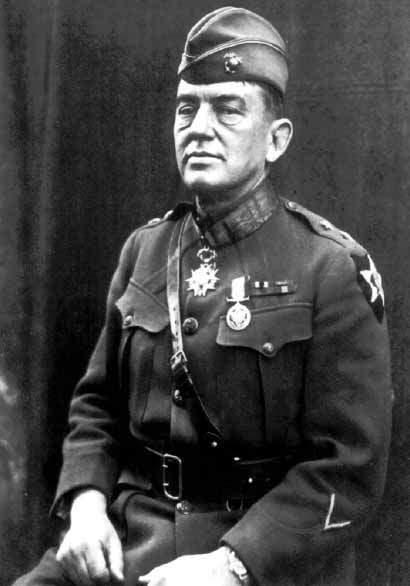
General John A. Lejeune
Lieutenant General John A. Lejeune (1867-1942), a graduate of the U.S. Naval Academy and Commandant of the Marine Corps from 1920 to 1929, was an early proponent of the amphibious assault plan. General Lejeune reorganized the Corps to reflect its new wartime mission, and ordered substantial improvements in training for the seizure by amphibious assault and defense of advanced naval bases, in addition to general education for officers and troops.
Amphibious Assaults
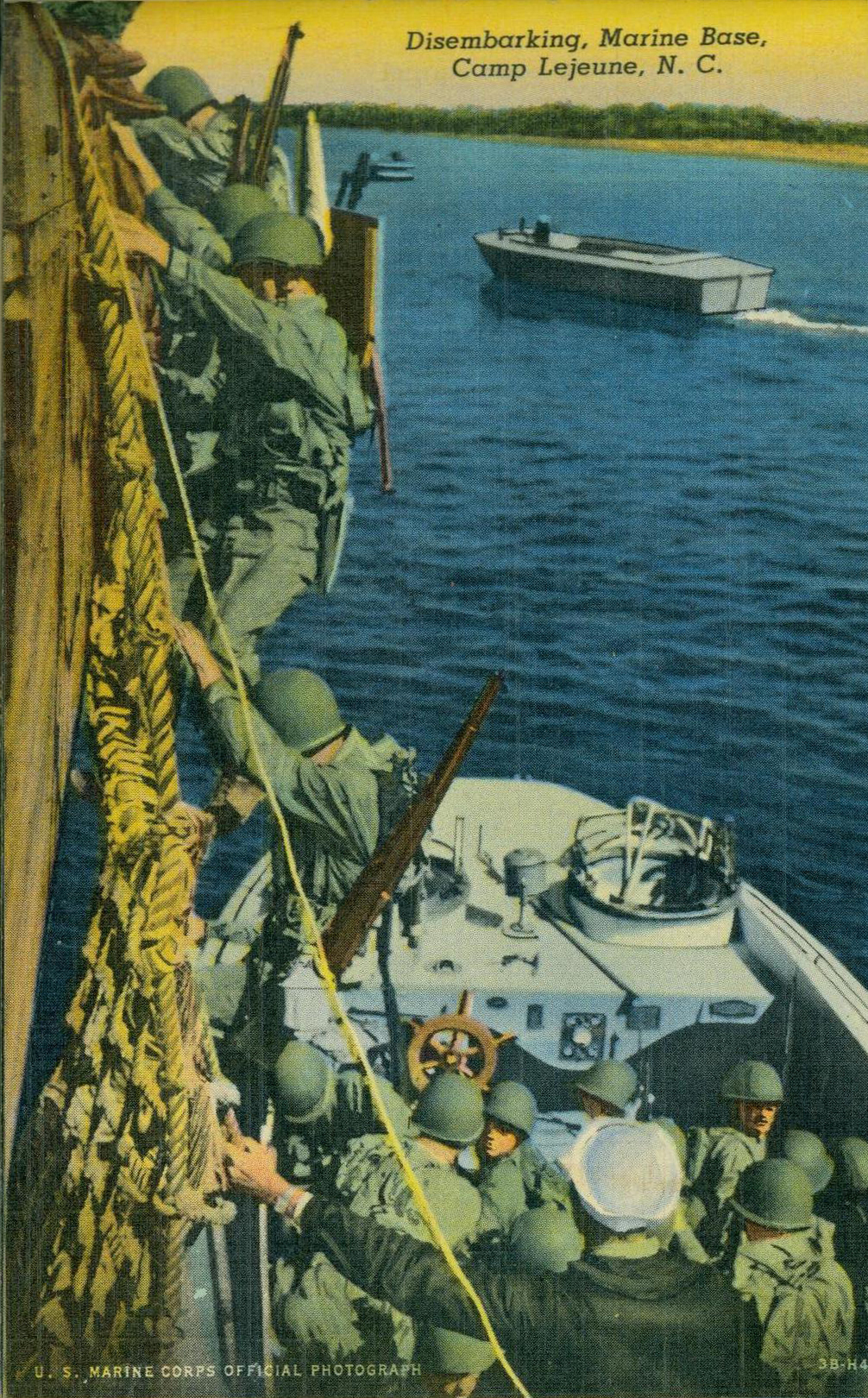
Disembarking Marine Base, Camp Lejeune, N.C.
Once the idea of seizing and defending advance bases had been more or less accepted among the Marine Corps leadership, debate centered on the issue of how exactly to carry out an amphibious assault. At that time a successful amphibious landing on a hostile shore was considered to be almost impossible. World War I had provided few successful examples of such operations, so the Marine Corps resorted to trial and error in a series of maneuvers and operational exercises—the latter in conjunction with the Navy and occasionally the Army—between 1921 and 1941. As a result of the exercises and continued refinement, by the early 1930s Marine Corps doctrine was committed to the new primary mission of amphibious operations in support of the fleet, which General Lejeune considered to be the raison d'être of the Corps, but there had been very few opportunities for the Corps to put their mission into actual practice.
The creation of the Fleet Marine Force (FMF) in 1933 marked a turning point in amphibious development, because with it the Marine Corps acquired the tactical structure necessary to carry out its primary wartime mission: to serve the fleet by seizing advance bases for naval operations, and, once captured, to occupy and defend these bases.
The U.S. Prepares for War and Marine Barracks New River Is Established
Toward War: Marine Corps Mobilization, 1939-1941

President Franklin D. Roosevelt delivers a wartime radio address.
In response to the rising tension in international politics during the 1930s, the United States began moving from a peacetime status to a state of increased military preparedness, despite a strong current of isolationist sentiment. But it was not until 1940, when Germany invaded Scandinavia, France, and the Low Countries, that the U.S. Congress finally authorized a two ocean navy and an accompanying naval building program.
READ MORE (Toward War)
Marine Barracks New River

Henry Weil’s Lodge at French Creek. Hunting and fishing camps developed throughout Onslow County during the late nineteenth century. Some wealthy visitors, such as Weil, established seasonal homes in the county.
Selection of a Site
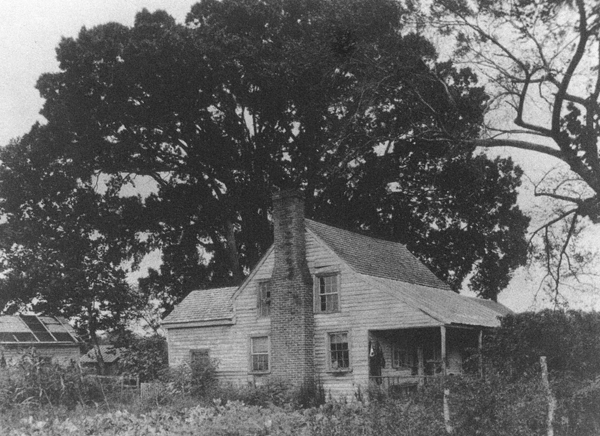
The Pearson House, formerly located near the town of Marines, was a typical example of the homesteads located in the area taken over for the development of the Marine Barracks.
In the summer of 1940 then Major General Thomas Holcomb, Marine Corps Commandant, ordered Major John C. McQueen to "select a pilot . . . get a plane . . . and find us a training center." Within a month, McQueen and his pilot, Captain Verne McCaul, embarked on an aerial survey that would ultimately cover the Atlantic and Gulf coasts from Norfolk, Virginia, to Corpus Christi, Texas. As they circled over the Onslow County coast, they saw below them 14 miles of undeveloped beach interrupted only by Brown's inlet. It was an ideal area for training, maneuvering large formations, artillery firing, and the construction of a major facility.
READ MORE (Undeveloped Land and Significant Construction)
Development Begins
 November 1941 land clearing activities in the area of the “airport,” Peterfield Point.
November 1941 land clearing activities in the area of the “airport,” Peterfield Point.
Marine Barracks New River was formally established on 1 May 1941 (the base's official birthday), but construction of base facilities had begun the previous month. The base's thick pine forests, dense underbrush, swamps, and hot, humid climate made it difficult to develop, not to mention unpleasant to inhabit. The vegetation, insects, and snakes reminded the Marines of the 1st MarDiv, who were initially assigned to the base, of a jungle, and one officer reportedly grumbled that after training here "[the] division . . . won't be fit for anything but jungle warfare," rather than the amphibious assaults for which they were training. Of course, this statement proved both ironic and prophetic, for by the summer of 1942 it had been determined that Marines would go to the Pacific, where they fought under conditions somewhat similar to those encountered at New River. Indeed, at Guadalcanal another Marine was quoted as saying, "If this place had more snakes, it would be just like New River."
READ MORE (Relocation of Local Landowners & Land Rights Relinquished)
Beginnings of a Base

The Gurganus Farmhouse, located in the Tent Camp are, was converted for use as the first base headquarters. It was later used as the headquarters for the 1st MarDiv.
In its preliminary planning for the new training base, the Marine Corps assigned to New River the 1st MarDiv, four defense battalions, and one amphibian battalion, in addition to a permanent battalion of post troops. The Corps also planned to move some specialist training there to relieve pressure at Quantico. Division training activities to be conducted at New River were extensive:
READ MORE (Beginnings of a Base)
Marines Arrive
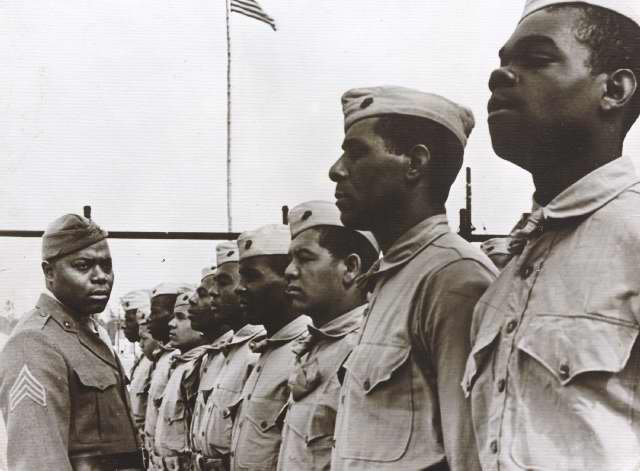
Sgt. Gilbert “Hashmark” Johnson looking over new recruits at Montford Point, 1943.
During the latter part of April 1941 the first Marines began arriving in the area. Arriving with them was Quartermaster Clerk (equivalent to today's warrant officer) Hubert G. Bozarth, a highly competent and resourceful young officer who would devote half of his career to the construction and maintenance of the New River base.
READ MORE (Marines Arrive)
Construction of a Modern Base
Following the attack on Pearl Harbor and the United States’ entry into World War II, the already remarkable pace of construction at Camp Lejeune was increased (Watson 1995:134). By the end of the war, the base was the most modern of its kind in the nation. After President Franklin D. Roosevelt issued Executive Order 8802 barring discrimination in defense programs in 1941, the first African American troops arrived to train at the Montford Point area of Camp Lejeune (Carraway 1946:51). Women were trained at the base in nearly all facets of the military (except combat) beginning in 1943 (Watson 1995:135). The camp hospital was completed in the same year. There was also a dog training school where hundreds of canines were prepared for war duty (Carraway 1946:35-36). Recreational facilities were expanded midway through the war and included nine movie theaters, a stadium, and a 36-hole golf course (Carraway 1946:23-27). At the end of the war, the base had stocked fish ponds, a bird sanctuary, and recreational beachfront (Carraway 1946:31-37).
READ MORE (Jacksonville Residential Growth)
First Phase of Construction, 1941
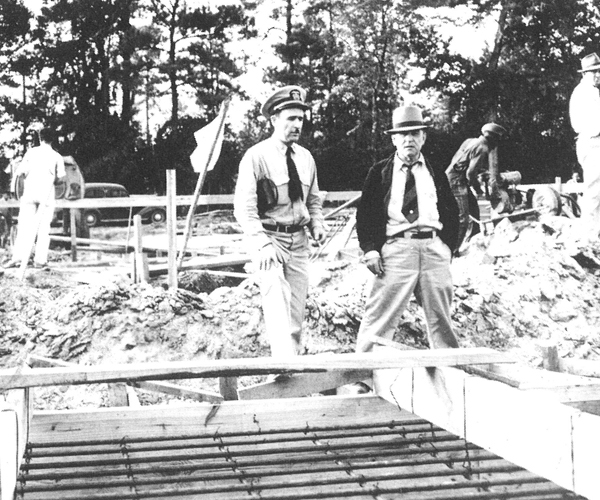
The Construction Officer inspects the progress of buildings at Marine Barracks New River.
The initial construction at the Marine Barracks New River occurred in four phases from early 1941 through the end of 1943. During the first phase, April 1941 to September 1942, construction in all of the principal areas of the base was completed or begun, with the exception of the Beach Area. The completed areas included Tent Camp No. 1; the Division Training Area, which housed the regiments; and the naval hospital at Hadnot Point.
READ MORE (Tent Camp)
READ MORE (Hadnot Point)
READ MORE (U.S. Naval Hospital New River)
Second Phase of Construction, 1942-1943
The second phase of construction, from October 1942 to March 1943, called for additional contracts totaling about $1.5 million to complete roads, piers, athletic fields and recreational facilities, plus dredging portions of the New River.
Third Phase of Construction, 1943
The third phase of construction, from March to September 1943, totaled $5.6 million and provided accommodations for the Women's Reserves (WR); expanded facilities at Montford Point, the separate training and housing facilities for the African-American Marines (Camps Nos. 2, 2A, and 3); and erected a segregated cantonment for African-American Marines at the Rifle Range, as well as a cantonment for the "Colored Labor" Battalion planned to be assigned to the Supply and Industrial Area, located east of the regimental areas along Holcomb Boulevard. This phase also featured construction of 30 "school buildings," mostly long one story clay tile buildings clad with stucco and trimmed with brick, in the Division Training Area at Hadnot Point and at the Rifle Range, located in the southwestern portion of the base at Stones Bay.
Fourth Phase of Construction, 1943
The fourth and final phase of the initial base construction, which extended through the last three months of 1943, provided a variety of utilities installations, erection of the three training pools, and a small cantonment for the Signal School at the Beach Area. The Signal School facilities consisted of three barracks, a mess hall, two school buildings, and a central heating plant.
By the end of 1943 the majority of World War II construction at Camp Lejeune, both temporary and permanent, was finished. The base had been planned from the beginning with an eye to long-term use, and much of the construction was completed as originally planned. Additions to the original layout raised the capacity of the East Coast Training Center to approximately 42,000 Marines, but because the preponderance of Corps activity was on the West Coast, Camp Lejeune did not reach its capacity until August 1945, after hostilities had ceased. Nevertheless, thousands of Marines received all or part of their training at Camp Lejeune, and the base lived up to its billing as the most complete Marine Corps training base ever built.
After the War
Following the war, Camp Lejeune continued as a training and support center for the Fleet Marine Force (FMF) and other units, and continued to grow. Many of the temporary structures were replaced by permanent buildings, and the years immediately after the war were characterized by the construction of new quarters, streets, and utilities (Darden 1985:70). This growth pattern continued through the late twentieth century, and culminated in 1992 with the acquisition of an additional 41,000 acres west of U.S. Route 17, an area known as the Greater Sandy Run Area (GSRA) (Berger 2006: 81). By the early 1990s the base boasted a population of approximately 110,000 (including non-military personnel), an area of over 152,000 acres, and over 7,650 structures (Berger 2006: 80).
REFERENCES
Brown, Joseph Parsons
1960 The Commonwealth of Onslow: A History. Owen G. Dunn, New Bern, NC Bureau of Land Management’s Historical Glass Bottle Identification and Information Website, (2006): http://www.sha.org/bottle/index.htm
Carraway, Gertrude S.
1946 Camp Lejeune Leathernecks. Owen G. Dunn Company, New Bern, NC.
Darden, William M.
1985 Camp Lejeune. In United States Navy and Marine Corps Bases, Domestic, P.E. Coletta and K. J. Bauer, eds. Greenwood Press, Westport. Pp. 67-71.
The Louis Berger Group
2006 Semper Fidelis: A Brief History of Onslow County, North Carolina, and Marine Corps Base, Camp Lejeune. United States Marine Corps.
Loftfield, Thomas C.
1981 An Archaeological and Historical Reconnaissance of U.S. Marine Corps Base, Camp Lejeune. Submitted to the Department of the Navy, Washington D.C. Ms. on file at the Office of State Archaeology, Raleigh.
Loftfield, Thomas C., and Tucker R. Littleton (compiler)
1981 An Archaeological and Historical Reconnaissance of U.S. Marine Corps Base, Camp Lejeune Part 2: The Historic Record. Submitted to the Department of the Navy, Washington D.C. Ms. on file at the Office of State Archaeology, Raleigh.
Onslow County Historical Society
1983 Heritage of Onslow County. Hunter Publishing Company, Winston-Salem, NC.
Onslow County News and Views
1941a Thousands Flock Here As Marine Base Begins. [1941]. Jacksonville, NC. On file at the Onslow County Museum, Richlands, FL.
1941b Marine Base Occupants Must Move; No Extension. Jacksonville, NC. On file at the Onslow County Museum, Richlands, FL.
1941c Oct. 1st New Deadline to Evacuate Marine Base. 22 August 1941. Jacksonville, NC. On file at the Onslow County Museum, Richlands, FL.
1941d More Checks Received for Marine Base Property. 17 June 1941. Jacksonville, NC. On file at the Onslow County Museum, Richlands, FL.
1941e Barden to be Present at Mass Meet Monday. [1941] Jacksonville, NC. On file at the Onslow County Museum, Richlands, FL.
1941f Funds Allocated Aid Marine Base Evacuees. [1941]. Jacksonville, NC. On file at the Onslow County Museum, Richlands, FL.